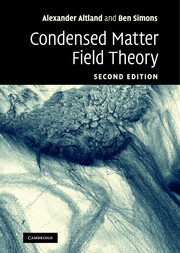Book contents
- Frontmatter
- Contents
- Preface
- 1 From particles to fields
- 2 Second quantization
- 3 Feynman path integral
- 4 Functional field integral
- 5 Perturbation theory
- 6 Broken symmetry and collective phenomena
- 7 Response functions
- 8 The renormalization group
- 9 Topology
- 10 Nonequilibrium (classical)
- 11 Nonequilibrium (quantum)
- Index
5 - Perturbation theory
Published online by Cambridge University Press: 04 August 2010
- Frontmatter
- Contents
- Preface
- 1 From particles to fields
- 2 Second quantization
- 3 Feynman path integral
- 4 Functional field integral
- 5 Perturbation theory
- 6 Broken symmetry and collective phenomena
- 7 Response functions
- 8 The renormalization group
- 9 Topology
- 10 Nonequilibrium (classical)
- 11 Nonequilibrium (quantum)
- Index
Summary
In this chapter, we introduce the analytical machinery to investigate the properties of many-body systems perturbatively. Specifically, employing the “ø4-theory” as an example, we learn how to describe systems that are not too far from a known reference state by perturbative means. Diagrammatic methods are introduced as a tool to efficiently implement perturbation theory at large orders. The new concepts are then applied to the analysis of various properties of the weakly interacting electron gas.
In previous chapters we have emphasized repeatedly that the majority of many-particle problems cannot be solved in closed form. Therefore, in general, one is compelled to think about approximation strategies. One promising ansatz leans on the fact that, when approaching the low-temperature physics of a many-particle system, we often have some idea, however vague, of its preferred states and/or its low-energy excitations. One may then set out to explore the system by using these prospective ground state configurations as a working platform. For example, one might expand the Hamiltonian in the vicinity of the reference state and check that, indeed, the residual “perturbations” acting in the low-energy sector of the Hilbert space are weak and can be dealt with by some kind of approximate expansion. Consider, for example, the quantum Heisenberg magnet. In dimensions higher than one, an exact solution of this system is out of the question. However, we know (or, more conservatively, “expect”) that, at zero temperature, the spins will be frozen into configurations aligned along some (domain-wise) constant magnetisation axes.
- Type
- Chapter
- Information
- Condensed Matter Field Theory , pp. 193 - 241Publisher: Cambridge University PressPrint publication year: 2010



